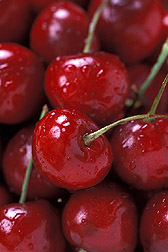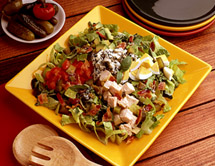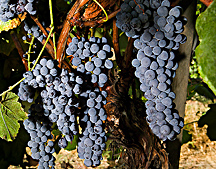| July 2006 |
Choline Helps Halt Harmful Homocysteine Buildup
|
|
Getting high—or at least adequate—levels of choline in meals and snacks may help prevent unhealthful buildup of homocysteine in your blood. High blood homocysteine levels are thought to increase risk of heart attack, stroke, dementia and cancer.
Choline powers our brains, converts fat into energy, and performs other essential biochemical activities.
Scientists at the ARS Jean Mayer USDA Human Nutrition Research Center on Aging at Tufts University, Boston, Mass., and their co-investigators examined the relation between choline intake and blood homocysteine levels that were recorded in food questionnaires or blood tests of 1,960 volunteers in the Framingham Offspring Study (American Journal of Clinical Nutrition, volume 83, pages 905 to 911).
Important choline sources include eggs, liver and other meats, fish, beans, wheat bran, nuts, dairy products and soy foods.
For details contact: Paul F. Jacques, (617) 556-3322; ARS Jean Mayer USDA Human Nutrition Research Center on Aging at Tufts University, Boston, Mass.
|
|
New Link Between Food and Eye Health Found
Female volunteers who ate a high proportion of "high-glycemic-index" foods over a 10-year period were more than twice as likely to develop an early indicator of age-related macular degeneration. This disease is one of the leading causes of irreversible vision loss among Americans aged 40 or above.
High-glycemic-index foods are rich in the type of carbohydrates that are quickly digested and absorbed, resulting in a rapid rise in blood sugar.
Scientists at the ARS Jean Mayer USDA Human Nutrition Research Center on Aging, Boston, Mass., note that the data do not establish a cause-and-effect interaction, but instead suggest a new direction for further studies that may help prevent or delay macular disease.
Results are based on eye tests and food questionnaires completed by 526 women aged 53 to 73 who did not have a history of the early form of the disease. An article in the April 2006 issue of the American Journal of Clinical Nutrition (volume 83, pages 880 to 886) tells more.
For details contact: Chung-Jung Chiu, (617) 556-3157; ARS Jean Mayer USDA Human Nutrition Research Center on Aging at Tufts University, Boston, Mass.
Young African-Americans' Low Vitamin D Levels Reported
|
|
African-American teenagers tested in a recent study had a greater incidence of low vitamin D levels than participants in several earlier investigations. University and Agricultural Research Service nutrition experts reported that finding in a recent issue of the American Journal of Clinical Nutrition (volume 83, pages 1135 to 1141).
Vitamin D is essential for strong bones. Good sources include vitamin D-fortified milk and juices as well as fatty fish, and sunshine—which converts a natural chemical in skin into vitamin D.
At sites in 14 American cities, the scientists examined levels of 25-hydroxy vitamin D in the blood (plasma) of 359 volunteers, predominantly African-American females aged 15 to 19. This form of the vitamin is a good indicator of total vitamin D stores. The researchers found that 87 percent of the volunteers—an unexpectedly high number—had an insufficient amount of 25-hydroxy vitamin D in their plasma.
For details contact: Charles B. Stephensen, (530) 754-9266; USDA-ARS Western Human Nutrition Research Center, Davis, Calif.
|
|
Saliva Attracts Scientists' Scrutiny
Proteins and other molecules that make up our saliva might change in response to what we eat, how and how often we exercise, and what nutritional supplements—such as multivitamin/mineral tablets—we use. That’s why ARS scientists and their co-investigators are analyzing the composition of saliva from healthy volunteers.
The information they’re gathering may someday serve as a standard or baseline for estimating the health of others, and for assessing an individual's response to a particular food, exercise regimen or supplement. Then, foods eaten or supplements taken could be adjusted accordingly, for optimal health.
The research might also yield findings that food processors and supplement manufacturers could use to develop new and improved products.
For details contact: Neil P. Price, (309) 681-6246; USDA-ARS National Center for Agricultural Utilization Research, Peoria, Ill.
Bing Cherries' Anti-Inflammatory Effects Documented
Bing cherries may help fight the inflammation of arthritis, heart disease and cancer, ARS scientists and their colleagues report in the April 2006 issue of the Journal of Nutrition (volume 136, pages 981 to 986).
Investigators at ARS’ Western Human Nutrition Research Center, Davis, Calif., led the research, which was based on tests of 18 healthy men and women volunteers, aged 45 to 61, who ate a total of about 45 fresh Bing cherries throughout the day for 28 consecutive days.
Blood samples indicated that levels of three telltale indicators of inflammation—nitric oxide, C reactive protein and a marker for T cell activation—dropped 18 to 25 percent by the end of the cherry-eating stint.
However, natural chemicals in cherries apparently work selectively, suppressing production of these three inflammation-linked compounds, but not of some three dozen others, the researchers found.
The grower-sponsored California Cherry Advisory Board, Lodi, Calif., helped fund the research.
For details contact: Darshan S. Kelley, (530) 752-5138; USDA-ARS Western Human Nutrition Research Center, Davis, Calif.
|
|
Zinc and Exercise: A Closer Look
Scientists already know that our muscles need zinc, but a study from investigators at the Grand Forks (N.D.) Human Nutrition Research Center provides new details about the key role of a zinc-dependent enzyme called carbonic anhydrase.
Consuming less than the recommended amount of zinc reduces the enzyme's activity and makes the heart work harder, the researchers showed.
Healthy men in their 20s and 30s volunteered for the 9-week, low-zinc regimen and for another 9-week regimen in which they received the recommended amount of this essential nutrient.
Workouts during the low-zinc stint left volunteers panting as their hearts worked harder to carry carbon dioxide to the lungs, where it is exhaled.
That's in contrast to the volunteers' performance during the regimen in which they received the recommended amount of zinc. The study, reported in 2005, provides the first evidence that the carbon-dioxide-removing enzyme won't perform normally in people during exercise if body stores of zinc are too low (American Journal of Clinical Nutrition, volume 81, pages 1045 to 1051).
Chicken, eggs, cheese, oysters, beef, beans and peanuts are rich in zinc.
For details contact: Henry C. Lukaski, (701) 795-8429; USDA-ARS Grand Forks Human Nutrition Research Center, Grand Forks, N.D.
Pickle Flavor Protected by Turmeric
|
|
Dill pickles sold in plastic pouches could stay fresh and flavorful longer if packed with turmeric. That spice is already used to add color to some pickles and certain other foods.
Unlike glass jars, gas-permeable plastic pouches allow oxygen to seep through, over time. But turmeric proved to be an effective antioxidant in lab tests that simulated commercial pickle packing processes, ARS and university researchers have shown (Journal of Agricultural and Food Chemistry, volume 48, pages 4910 to 4912).
Why pack pickles in plastic instead of glass?
Plastic containers weigh less, don’t break and are easier to open.
For details contact: Roger F. Mcfeeters, (919) 515-2990; USDA-ARS Food Science Research Unit, Raleigh, N.C.
Today's Pork: Leaner Than Ever
|
|
Eight of nine retail cuts of pork analyzed by Agricultural Research Service nutrition scientists and their colleagues were leaner than cuts measured a decade ago—yet still provided the same amount of protein.
“The Revised USDA Nutrient Data Set for Fresh Pork” revisits the nutrient content of shoulder blade steak, tenderloin roast, top loin chop, top loin roast, sirloin roast, loin chop, rib chop, country style ribs, and spare ribs. View it on the World Wide Web at: www.ars.usda.gov/Services/docs.htm?docid=13467.
The data can be used as the basis of nutrition labels for pork products. The National Pork Board, Des Moines, Iowa, helped fund the research.
For details contact: Juliette C. Howe, (301) 504-0643; USDA-ARS Beltsville Human Nutrition Research Center, Beltsville, Md.
|
|
Black Pearl Pepper Plant Wins Garden Prize
Black Pearl, an edible ornamental pepper from Agricultural Research Service scientists in Beltsville, Md., has been named a 2006 All-America Selection. The award recognizes new flowers and vegetables that demonstrate “superior garden performance” in trials conducted throughout the country.
Black Pearl was first offered to growers and gardeners in 2005, after years of testing. Its black leaves and dense clusters of round fruits that ripen from black to red make it an especially eye-catching plant. In addition, it is drought-hardy and tolerant to attack by common insect and disease pests.
PanAmerican Seed Company, Elburn, Ill., helped test the plant and entered it in the national competition.
For details contact: John R. Stommel, (301) 504-5583, or Robert J. Griesbach, (301) 504-6574; USDA-ARS Henry A. Wallace Agricultural Research Center, Beltsville, Md.
New Pinto Beans Resist Diseases
|
|
Five new kinds of pinto beans shrug off attack by three major bean diseases.
Known as “BelDakMi-RMR” and numbered 19 to 23, the new lines contain a record-setting total of six disease-resistance genes—four to fend off common bean rust, one to foil common mosaic virus, and one to resist common mosaic necrosis virus.
That’s unlike most commercial bean varieties, which typically contain few if any disease-resistance genes. What’s more, the BelDakMi pintos thwart every known strain of these pathogens
The beans get their “BelDakMi” name from abbreviations of the institutions that collaborated in their development—ARS’ Henry A. Wallace Beltsville (Md.) Agricultural Research Center, and North Dakota State and Michigan State universities.
Pinto beans provide protein, carbs, fiber, iron and folate.
For details contact: Marcial Pastor-Corrales, (301) 504-5745; USDA-ARS Henry A. Wallace Beltsville Agricultural Research Center, Beltsville, Md.
New Muscadine Grape: Healthful—With Improved Flavor
There's good news for fans of muscadine grapes. ARS scientists in Poplarville, Miss., and their University of Florida colleagues are putting the finishing touches on a new, fresh-market muscadine that will offer excellent flavor and high levels of compounds known as phenols, thought to benefit our cardiovascular system.
Muscadines are grown commercially in the southeastern United States, where they are often called scuppernongs and are used primarily in juices, wines, jellies and preserves. They are valued for their high yields—8 to 12 tons an acre—and for resistance to pests such as phylloxera, nematodes, fungi, and the microbe that causes Pierce's disease.
For details contact: Stephen J. Stringer, (601) 403-8768; USDA-ARS Southern Horticultural Laboratory, Poplarville, Miss.
Thomcord Grape Deliciously Blends Concord and Thompson Seedless
|
|
Already a hit at farmers' markets in central California, a specialty grape called Thomcord may begin showing up in supermarket produce sections across the county within the next few years.
Agricultural Research Service grape breeders in California chose two classic grapes, Thompson Seedless and Concord, as parents of Thomcord. They put the new grape plants through 17 years of testing before making it available in 2003 to nurseries and plant breeders.
Thomcord has the blue-black skin and whitish bloom of the Concord, plus a pleasing Concordlike flavor that's lightened by the sweet, mild taste of its Thompson parent. The fruit is slightly firmer than Concord and is seedless, ripening in late July through mid-August in California.
For details contact: David W. Ramming, (559) 596-2823; USDA-ARS San Joaquin Valley Agricultural Sciences Center, Parlier, Calif.













